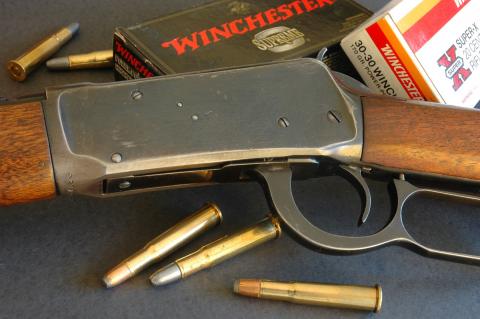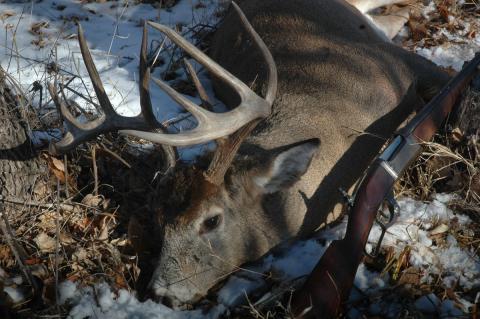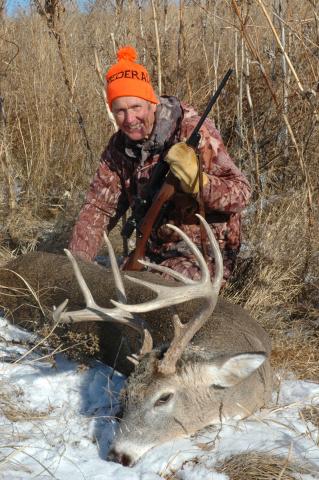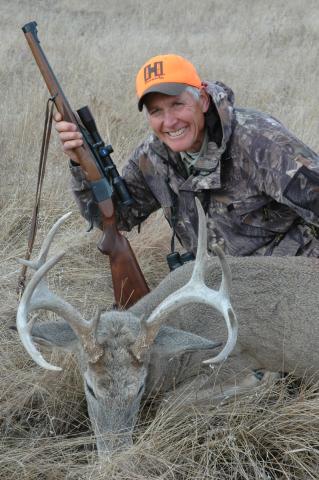Rediscovering The Whitetail
Two months after James Jordan died in 1978, a buck he’d shot six decades earlier near Danbury, Wisconsin became, officially, his. It had topped records lists for typical whitetails since 1965, but its provenance then was unclear. The antlers belonged to Bob Ludwig, who’d bought them for $2 from a second-hand store. But Jordan’s compelling tale was at last accepted as true.
On November 20, he had jumped the deer from weeds near a rail bed and hit it with a volley that left one round in his .25-20. Persevering on the track, he glimpsed the wounded deer across the Yellow River. His last shot felled it. A local taxidermist took $5 as full payment for a shoulder mount, but then moved to Grindstone Lake, Minnesota. The deer went too, but did not follow the taxidermist on his later move to Florida. The Grindstone Lake house stood vacant 40 years, selling for taxes in 1959. The antlers resurfaced where Ludwig bought them.

I had been hunting deer for 12 years in 1978 and had killed very few. Tales like that of the Jordan buck kept pulling me afield. But such deer were as rare as unicorns. Even an honest eight-point remained a dream. My fruitless hunts were like those of many Michigan lads coming of age in the 1960s when the Upper Peninsula was storied deer country.
After war’s end in 1945, hunters swarmed out of Detroit to crawl, bumper to bumper, across the Mackinac Bridge. Northern forests harbored outsize bucks that lost none of their weight over campfires. Michigan’s favorite son, Fred Bear, had first motored north for deer in 1929. He and two pals reached St. Helen, as far as their kitty would fuel their Model A. They camped in a cold cedar swamp. They shot no deer. Six years later, Fred would arrow his first at Blaney, a tract of U.P. timber.
In 1942, Bear and Jack Van Coevering of the Detroit Free Press returned to film a bowhunt there. In bitter weather, Fred fumbled an arrow to muff his only chance. Hands numb with cold, he “could hardly get boots and wet socks off” over the noon fire. I could relate to that.
But hardship and deerless days had melted from memory when a doe dashing through “popples” not far from Bear’s hometown of Grayling tumbled to a bullet from my SMLE, a $30 rifle I’d restocked with $7.50 walnut from Herter’s. Its Williams open sights had cost $15, a deer license another $5.
By 1978, I was living and hunting in eastern Oregon, spending more on rifles and deer tags. I had yet to find a big buck, but that failure didn’t diminish the hunt. Meantime, whitetails had moved steadily west. In Colorado that year, Ivan Rhodes went hunting. Opening morning showed him not one deer; but in late afternoon on his way back to trailhead, Ivan spied what appeared to be a cow skeleton in a brushy draw. Then the bones moved! Ribs became antlers! At 30 yards, one .30-’06 bullet killed the first Colorado whitetail to qualify for the records book. The state’s eastern slope has since produced others.
The whitetail has not driven the mule deer from its native range so much as it has filled voids and better adapted to a changing West. Plentiful across much of the Louisiana Purchase, mule deer diminished after pioneers shot them for meat. The Homestead Act of 1862 was hard on deer. Settlers cut timber from prairie creases, then plowed the flats. In 1879, John Wesley Powell suggested 2,560 acres as a viable plot for a homesteading family. Congress allocated 160. Overgrazing ensued.
After shooting bison to remnant numbers, market hunters sold venison to railroad gangs and steamboat crews. Brutal winters in 1886 and ’87 rested the range by killing 80 percent of its cattle. Deer died too, however, and more cattle came. Depression and the Dust Bowl drove farmers off the land, and WW II sent hunters overseas. Mule deer herds recovered.
During the late 1940s and ’50s, mule deer hunting was as good as it may ever be. Mild winters followed decades of heavy livestock grazing that had replaced grass with brush. Domestic sheep pruned that forage, keeping it young and nutritious. Poison and aerial gunning reduced coyote predation.
Such a convergence of blessings is unlikely to repeat anytime soon. Western range now has fewer sheep, more coyotes. Fire control throttles plant succession. Wolves kill deer. Elk have increased, digging deeper and traveling farther than deer to survive in winter’s snow. Deer hunters are more numerous, more mobile and equipped to kill at longer range. Most importantly, our human population keeps growing, each year adding more than 7,000 people. We pave 11,000 miles of roads annually and build homes where deer live. From the North Dakota oil patch to ski slopes in Colorado, western deer habitat is shrinking.
But whitetails have prospered, on the high plains and the hem of the Rockies as well as in Eastern hardwoods and on Midwestern farms. No matter where you live, big game hunting lies close! Whitetails offer almost everything you might get hunting far from home. Dangerous they’re not, but mature whitetail bucks are among the most elusive game. Still-hunting or tracking them tests your woodsmanship. They’re quieter than elk, and harder to see in cover. Keen senses – eyes, ears and nose – catch your blunders. So fast they make Cape buffalo look sluggish, deer vanish in cover too thin to hide a smile. The challenge of hunting whitetails has kept me on their trail decades after I despaired of finding a big one. In woodlot and forest, on desert and prairie and mountain, whitetails have beaten me often.

Last year, still-hunting the edge of a treed bottom in South Dakota, I glimpsed a wink of white in cedars. A buck emerged, slipping through tall grass toward the timber. I ducked into a cut, then angled toward him quickly. At trees’ hem, he paused, quartering. I pegged the bead of my .25-35 to his rear rib. The hit sent him flagging off. As brush and swamp-grass made trailing ever more difficult, a flick of his tail caught my eye. There’d be no other chance. Again offhand, I sent a bullet to his flank, then another. The animal collapsed, a fine buck, shot with a century-old Savage rifle bored for a cartridge all but obsolete. I couldn’t have been happier if I’d downed a 60-inch kudu!
A rippling tide of grass had hidden the buck until Travis spotted an antler tine. But the animal had seen us, and before we could duck, he and a doe sped away through a cleft in the hills. We followed quickly, keeping to the shadow of a ridge. When we eased to its top, both whitetails had paused on a treeless slope, watching back. I bit my lip. “He’s over 300 yards. Too far.”
Travis said nothing. He’d seen many hunters take shots that long. Hoping the deer would stay for just a few minutes, I backed off, scooted crosswind and closer, then bellied to the crest of a knob, nosing the Ruger carbine through a bush. Grass hid the doe, but the buck came clear in my 4x Zeiss. Bang! That deer fell to the same .303 load I’d used to take my first whitetail.
Since then, I’ve been blessed with other prairie bucks in South Dakota, Kansas, Nebraska. While BLM and USFS tracts aren’t as common as farther west, public hunting areas abound. Private hunting on ranches with fee access is another option. On such property in Nebraska’s Sand Hills, I shot a dandy buck.
Tribal reservations in South Dakota offer good odds for drawing whitetail tags. November weather on the high plains ranges from bluebird to blizzard. During my first Dakota hunt, snow piled to the over-passes on I-90, closing it. Cattle crossed fences to perish in remote pockets with no accessible forage. My tribal guide (required) watched from his pickup as I waded drifts to probe plum thickets. One yielded a buck.
In succeeding years, Badlands summers lingered into deer season. Once, as I slipped along a bluff on November 11, a rattler buzzed, inches from my knee. Snakes mind the mercury, not the calendar! But picnic weather doesn’t move deer. Cold, windless mornings roust them; snow makes them easier to spot. Even in the open, however, whitetails can disappear. Once I watched a pair cross a treeless wash to climb onto rolling pasture well within range. Then, as diving ducks riding chop, they slipped from sight, blinked into view and vanished again! Movement to the side caught my eye – they were past me! I pivoted, prone. My .270 took the buck quartering away. Those deer had moved across grazed pasture undetected!

That wash has been kind to me, yielding several bucks over as many seasons. Country that seems featureless to us is not so to deer. Where there are no barriers to deer traffic, the animals still take favored routes. Where each plum thicket or grass pocket looks the same as the next to us, deer prefer one over the rest. I’ve shot two bucks from a patch of weeds on the rim of a hollow that opens to a broad plain below, a cedar hedgerow above. Good wind coverage, multiple escape routes and a splendid view of approaching threat make it a natural bed site. But I had to study it to see what the deer see, and watch them travel into and out of it to confirm its value.
Given the whitetail’s wide range and adaptability, finding deer country is easier than finding the deer that live there. Deer are hard to see mainly because they mimic the insignificant. They’re the color of background, with a texture that diffuses light. Limbs, grass and shadow impose confusing patterns. To cut through this veil, look between and beyond what you know is not a deer. Your hunter’s eye craves details peculiar to a buck. Antlers, for instance. Ivory-hued bone pops from dark cover. Ditto a tail fringe or the glint of an eye. But such obvious clues – like the front-lit profile of a deer against contrasting background – are often obscured. You must also discern less distinctive parts.

Stop often when still-hunting, where you can see behind and to the sides, as well as forward. Each step opens new windows into cover. Look before they close. You’ll see detail best when you’re still. Not just pausing to look, but with head and eyes motionless. To study a suspicious form, deer stand stone-still. You’re smart to do the same. Moving your feet or turning your head, you miss details as cover slides by in a blur. Instead, read a slice of cover as you would a page in a book.
Look close before looking far. A deer you miss nearby is almost surely lost, as you’ve squandered the moments it has allowed you for a shot. Distant deer are less likely to have discovered you or to have sensed an immediate threat.
Look low. Talking with other people and using tools and appliances, we’re accustomed to looking at eye level. Deer stand nearer waist-high. Sneaking whitetails move in a crouch. Bedded bucks hide by hugging the earth.
Use a binocular, not just far but up close. While the resolving power of good glass helps your eye sift deer from distant background, it’s most helpful where seeing bucks before they detect you is crucial! In cover, focus the binocular for the distance! Maybe that’s 20 steps. It’s certainly not infinity!
Many deer, like Ivan Rhodes’s Colorado buck, have fallen up close. In 1953, after Marlin began listing its Model 336 in .35 Remington and Winchester presented its two-millionth Model 94 to President Eisenhower, whitetail hunter Ed Stockwell hiked into Arizona’s Santa Rita Mountains. Climbing a brushy ridge, he flushed two Coues bucks. They jetted toward the crest, vanishing in a wink. Ed scrambled after them, but quickly despaired of a shot. Turning to descend, he glimpsed movement behind an oak. One of the deer had hooked back, to hide! At 60 yards, Ed dropped the buck with his iron-sighted Savage 99. The antlers, he now saw, were huge! Later, they scored over 144 – so many inches the Boone & Crockett Club delayed a listing to ensure this was indeed a Coues deer. It’s still the world’s record.
Two years ago, I spotted a big whitetail on a prairie butte, bungled the sneak and knew my chance had gone. An hour later, on a flat half a mile away, I bellied toward antler tips. The impossible happened when my .25-’06 bullet found a window in the weeds to kill that same buck 80 steps away.
My odds of killing a better deer are slim. The odds I’ll stop hunting whitetails? Darned near zero!–Wayne Van Zwoll

